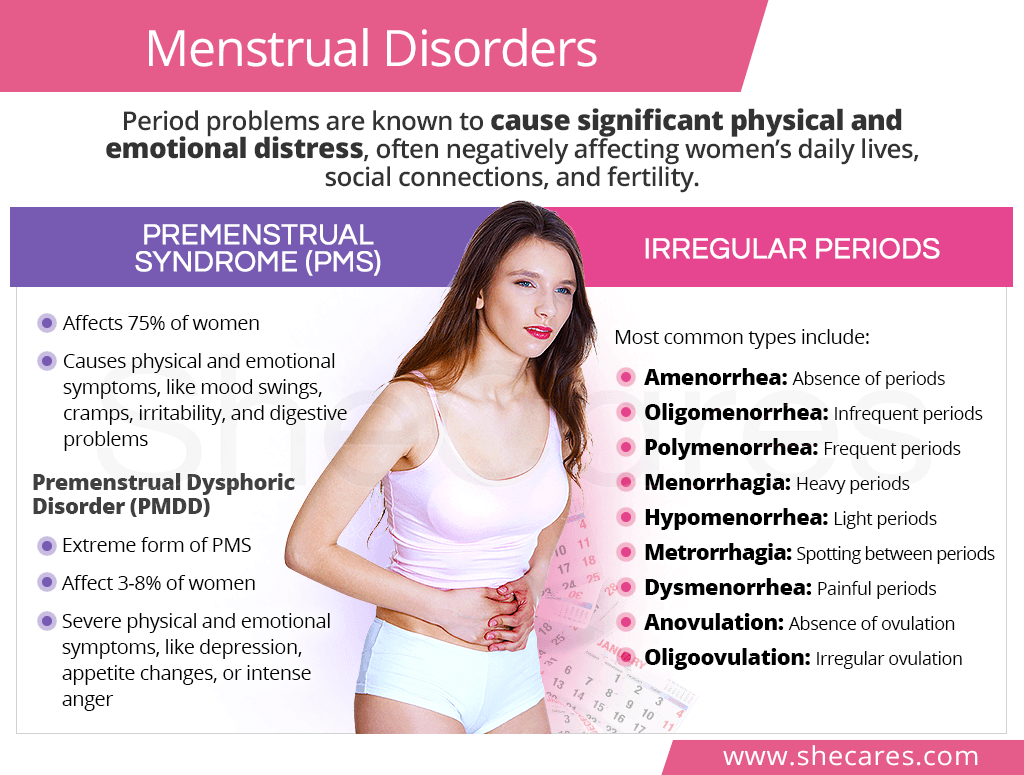What is a Menstrual Disorder?
A menstrual disorder is any irregularity in a menstrual cycle that may affect its length, flow, or symptoms that it might bring about.
For reference, a healthy menstrual cycle has the following characteristics:1,2
- The cycle is 21 to 35 days long.
- The bleeding lasts for 3 to 7 days.
- Total blood loss per period is about 2.7 oz. (60 mL).
- It might cause mild period symptoms a day or two before and a day or two into bleeding.
Common Menstrual Disorders
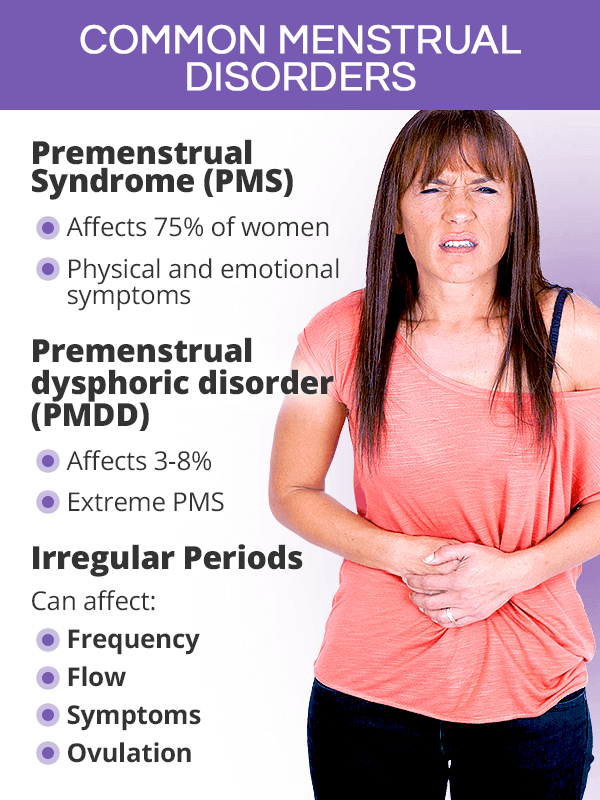
The most common menstrual issues that women might experience during their reproductive years usually fall into one of two categories: premenstrual syndrome (PMS) or irregular periods.
PMS
PMS is a common menstrual disorder that affects three out of four women up to two weeks before a period and causes a range of physical and emotional symptoms, such as mood swings, cramps, irritability, or trouble sleeping.3
About 3-8% of women suffer from a severe form of PMS, which is medically known as premenstrual dysphoric disorder (PMDD) and can cause extreme emotional symptoms, like depression, intense anger, or changes in appetite.4
Irregular Periods
Irregular periods - as the name suggests - are cycles that differ from the aforementioned characteristics of healthy periods in relation to their length, flow, volume of blood loss, and associated symptoms. The most common types include:
- Amenorrhea: Absence of periods
- Oligomenorrhea: Infrequent periods (long cycles)
- Polymenorrhea: Frequent periods (short cycles)
- Menorrhagia: Heavy periods
- Hypomenorrhea: Light periods
- Metrorrhagia: Spotting between periods
- Dysmenorrhea: Painful periods
- Anovulation: Absence of ovulation
- Oligoovulation: Irregular or infrequent ovulation
Causes of Menstrual Disorders
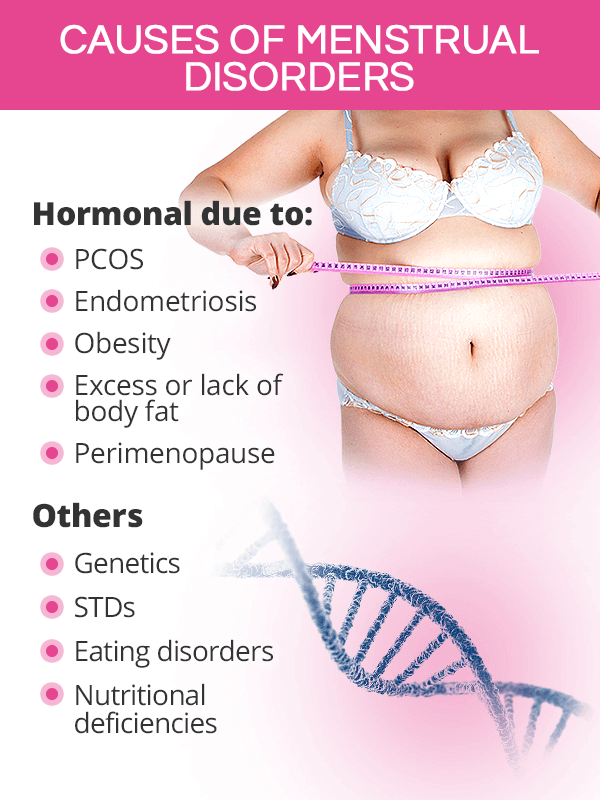
Causes of periods problems are many and can be generally classified in two groups: those with hormonal roots and non-hormonal roots. They are as follows:
Hormonal Causes
Hormonal imbalance is by far the most common cause of menstrual disorders, which can be brought about by a wide variety of conditions or lifestyle practices, including:
- Polycystic ovary syndrome (PCOS)
- Endometriosis
- Thyroid disease
- Low or high levels of body fat
- Perimenopause
- Primary ovarian insufficiency (POI)
- Diabetes
- Cushing's syndrome
- Birth control
- Uterine fibroids or polyps
- Stress
- Excessive exercise
Other Causes
Period problems can also have roots that lie outside of hormonal influences. There are also cases when the exact cause cannot be pinpointed.
- Genetics
- Sexually transmitted diseases (STDs)
- Eating disorders
- Uterine or cervical cancer
- Nutritional deficiencies
- Side effects of medications
- Pelvic inflammatory disease (PID)
Menstrual Problems Diagnosis
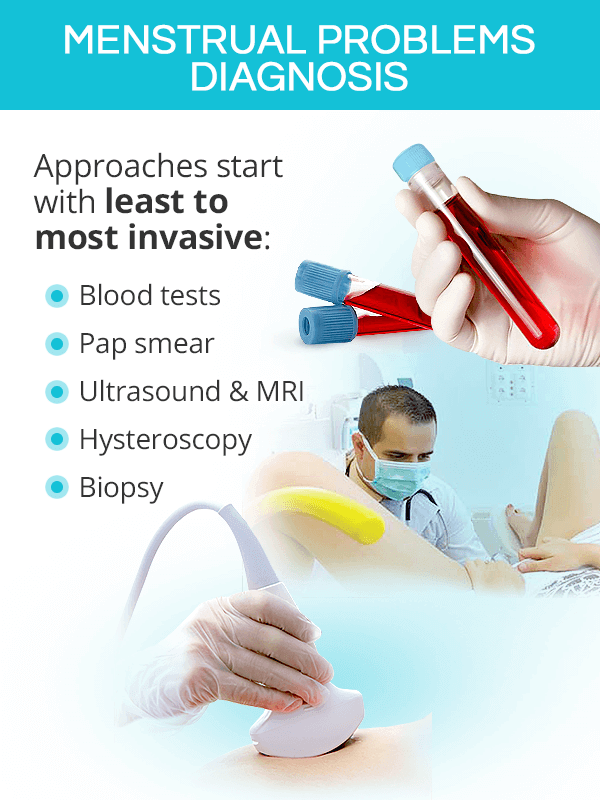
The efforts to diagnose menstrual problems is generally initiated based on reported symptoms. Typically, a doctor will begin with the simplest and least invasive tests to then proceed to more advanced ones as necessary.
Depending on the suspected underlying causes of period disorders, testing might include the following:
Blood tests: to pinpoint hormonal imbalance, nutritional deficiencies, signs of infection, etc.
Pap smear: to rule out cervical cancer, inflammation, or STDs
Imaging (ultrasound or MRI): to view the reproductive organs to check for endometriosis, PCOS, etc.
Hysteroscopy: to examine the cervix and uterus for polyps, fibroids, and other abnormalities
Endometrial biopsy: to take a sample of the uterine lining for abnormal changes
Menstrual Problems Treatment
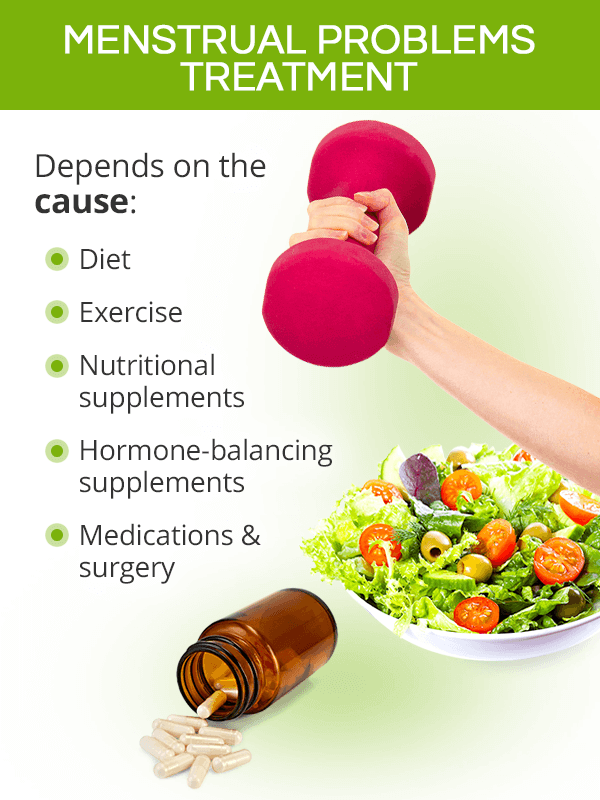
Treatment for menstrual disorders will greatly depend on the underlying cause and a woman's reproductive plans.
Since the most common cause of period problems is hormonal imbalance, a huge majority of treatments will focus on restoring healthy hormone levels, alongside cause-specific treatment approaches.
Lifestyle Changes
Reaching hormonal balance starts with conscious daily choices and wholesome practices a woman can implement for physical and emotional health, which translate to optimally healthy and regular menstruation.
Healthy diet is key for the nourishment of the female reproductive system, prevention of nutritional lacks, and proper weight maintenance, especially when enhanced with phytoestrogenic foods, like flax, apples, oats, or soy.
Exercise consisting of regular moderate-level intensity workouts for 150 minutes per week can not only help women reach and maintain adequate weight for menstrual health, but also relieve stress and improve mood.
Stress-relieving techniques come in a variety forms, like meditation, deep breathing exercises, or yoga.
Alternative Medicine
In addition to wholesome lifestyle practices, the use of alternative medicine can prove effective in restoring hormonal balance and relieving the symptoms of period issues. They come in three types:
Nutritional supplements, such as those containing iron or vitamin D, can be adequate for those whose period disorder is caused by diagnosed deficiencies in key nutrients.5
Phytoestrogenic supplements, like red clover or chasteberry, provide the body with plant-based compounds that mimic estrogen in the body and help bring hormone levels to balance.
Hormone-regulating supplements, like Macafem, works by safely and effectively stimulating the body's endocrine glands to up their hormone production, thus relieving symptoms long-term.
Conventional Medicine
Conventional medicine offers two approaches to treating menstrual cycle problems: medications or surgery.
Medications may include hormone treatment for period problems due to thyroid disorders; antibiotics or anti-parasitic drugs for STDs; oral contraceptives for excessive bleeding; and analgesics for painful periods.
Surgery, like endometrial ablation, dilation and curettage (D&C), or hysterectomy, can be the treatment of choice for heavy periods, uterine fibroids, or endometriosis.
Key Takeaways
It is understandable why some women struggling with menstrual problems, including heavy, long, or painful periods, might dread that time of the month. However, it is worth thinking of female menstruation as a reflection of one's health, both physical and emotional. Consequently, any period issues are important cues that something in the body is out of balance and needs care.
While there might be a number of potential causes, most period problems are rooted in hormonal imbalance brought about by PCOS, endometriosis, unhealthy weight, and other factors. Likewise, most common treatment revolves around restoring hormonal balance and relieving symptoms through diet, exercise, and stress-relief; herbal supplements; or other approaches. With the right attitude and determination, hormonal balance and menstrual health are just within reach!
Sources
- Baylor College of Medicine. (n.d.). Menstrual Disorders. Retrieved November 21, 2019 from https://www.bcm.edu/healthcare/care-centers/obstetrics-gynecology/conditions/menstrual-disorders
- Health Direct. (n.d.). Period problems. Retrieved November 21, 2019 from https://www.healthdirect.gov.au/period-problems
- Eunice Kennedy Shriver National Institute of Child Health and Human Development. (2017). Menstruation and Menstrual Problems. Retrieved November 21, 2019 from https://www.nichd.nih.gov/health/topics/menstruation
- Eunice Kennedy Shriver National Institute of Child Health and Human Development. (2017). What causes menstrual irregularities? Retrieved November 21, 2019 from https://www.nichd.nih.gov/health/topics/menstruation/conditioninfo/causes
- Mayo Clinic. (2019). Menstrual cycle: What's normal, what's not. Retrieved November 21, 2019 from https://www.mayoclinic.org/healthy-lifestyle/womens-health/in-depth/menstrual-cycle/art-20047186
- NHS. (2019). Period problems. Retrieved November 21, 2019 from https://www.nhs.uk/conditions/periods/period-problems/
- Office on Women's Health. (2018). Period problems. Retrieved November 21, 2019 from https://www.womenshealth.gov/menstrual-cycle/period-problems
- Office on Women's Health. (2018). What happens during the typical 28-day menstrual cycle? Retrieved November 21, 2019 from https://www.womenshealth.gov/menstrual-cycle/your-menstrual-cycle
- Office on Women's Health. (2018). Your menstrual cycle and your health. Retrieved November 21, 2019 from https://www.womenshealth.gov/menstrual-cycle/your-menstrual-cycle-and-your-health
- Summa Health. (n.d.). Menstrual Disorders. Retrieved November 21, 2019 from https://www.summahealth.org/medicalservices/womens/aboutourservices/gynecological-services/menstrual-disorders
- The Obstetrician & Gynaecologist. (2003). The management of menstrual disorders in early reproductive life. Retrieved November 21, 2019 from https://obgyn.onlinelibrary.wiley.com/doi/pdf/10.1576/toag.5.3.136
- University of Miami Health System. (n.d.). Abnormal Bleeding and Menstrual Disorders. Retrieved November 21, 2019 from https://umiamihealth.org/en/treatments-and-services/obstetrics-and-gynecology/abnormal-bleeding-and-menstrual-disorders
Footnotes:
- InformedHealth.org. (2017). Heavy periods: Overview. Retrieved November 21, 2019 from https://www.ncbi.nlm.nih.gov/books/NBK279294/
- Cleveland Clinic. (2019). Abnormal Menstruation (Periods). Retrieved November 21, 2019 from https://my.clevelandclinic.org/health/diseases/14633-abnormal-menstruation-periods
- Journal of Psychiatry & Neuroscience. (2000). Premenstrual syndrome and premenstrual dysphoric disorder: guidelines for management. Retrieved November 21, 2019 from https://www.ncbi.nlm.nih.gov/pmc/articles/PMC1408015/
- Casper. R. (2019). Patient education: Premenstrual syndrome (PMS) and premenstrual dysphoric disorder (PMDD). Retrieved November 21, 2019 from https://www.uptodate.com/contents/premenstrual-syndrome-pms-and-premenstrual-dysphoric-disorder-pmdd-beyond-the-basics
- Nutrients. (2018). The relationship between vitamin D status and the menstrual cycle in young women: a preliminary study. Retrieved November 21, 2019 from https://www.ncbi.nlm.nih.gov/pmc/articles/PMC6265788/
